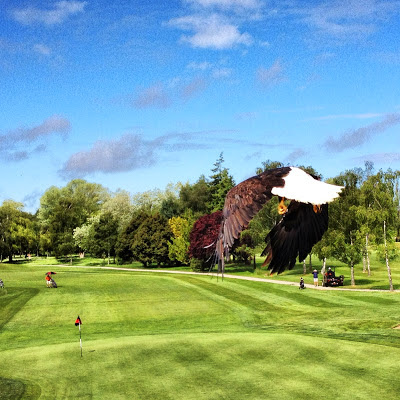If you've played here at Quilchena since Wednesday, I'm sure you noticed the renovation we completed at the front of #13 green. We removed a "sand-dam" that had become quite pronounced over the years and even resulted in some turf loss last winter/spring. What exactly is a sand-dam you ask? A sand-dam is a ridge that develops, typically along the outside perimeter of putting greens, from years and years of routine sand topdressing and matting. This grade of this ridge is higher than both the putting surface and the approach to the green which results in poor playability of the approach and worse yet, very poor surface drainage. The water that would typically drain off the surface if the grade was proper remains trapped in the low lying area and causes extremely saturated turf conditions. These areas often puddle during and after rainfall or longer irrigation cycles.
 |
| Area to be renovated marked with paint |
Traffic from maintenance equipment and golfers further add to the problem as these areas become highly compacted. The end result is poor draining turf and ultimately unhealthy turf. Poor draining turf is very susceptible to a soil condition called "black layer". This black layer, as seen in the photo below, is a "toxic" anaerobic environment for turf roots and results in turf loss, as we experienced at the front edge of #13 green.
 |
| Black layer exposed below the surface where turf was lost |
There are several different ways to remove a sand-dam, all depending on the severity of the sand-dam itself. If it is determined to be a minor ridge that hasn't developed into a significant ridge yet, it can be removed by aerating the sand-dam area with solid or coring tines and then rolling the turf over and over again. The holes created by aerating allow the soil to displace with the weight of the roller. This method is essentially "ironing out" the ridge and correcting the improper grade. This has proven to be a very successful approach for us here at Quilchena with correcting minor sand-damming issues.
The sand-dam at #13 was deemed to be a major one so the "ironing out" method simply wasn't going to cut it. We needed to take a more drastic approach to properly correct this very pronounced sand-dam. The entire area needed to be renovated and as you can see in the series of project photos below, this was a not just a "minor fix", but our Turf Care team doesn't shy away from hard work and they took on the project head on!
 |
| Sod stripped from the lower putting green was staged for the renovation |
|
|
 |
| Sod being stripped and removed |
 |
| Close-up of the Black Layer that was exposed under the surface where turf was lost |
 |
| Black Layer portion being removed and replaced with new greens mix |
 |
| Old and compromised drainage discovered just inches below the surface - no surprise here! |
 |
| Sand-dam ridge being stripped and properly graded |
 |
| Sand-dam removed and finish grade completed - ready for starter fertilizer and sod |
 |
| Sod carefully being placed and knitted together |
 |
| Finished product |
As you can see, there are many steps required to properly remove the sand-dam and restore the affected area. The renovated area has been marked as GUR and will remain as GUR until the sod has rooted and it can handle regular traffic. This was by far our worst sand-dam on the course, but we do have some others that aren't quite as pronounced that will need to be addressed in the near future. We will continue to work on them throughout the season.
Lastly, here are a couple "before & after" photos that best illustrate the grade corrections we accomplished:
 |
| Before & after - #13 sand-dam removal |
 |
| Before & after - #13 sand-dam removal |




















